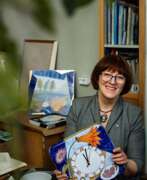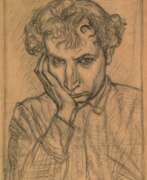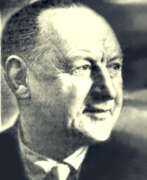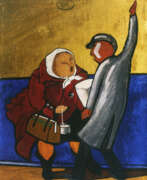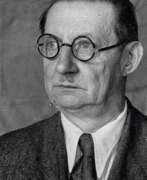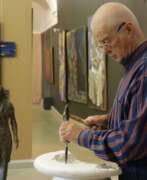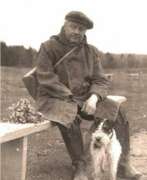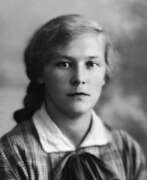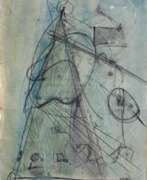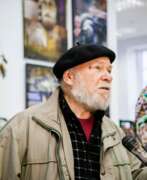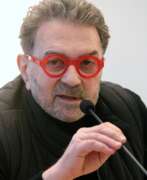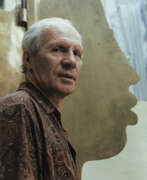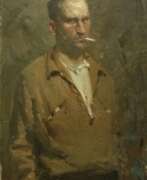Russia Contemporary art


Victor Ashotovich Abramyan (Russian: Виктор Ашотович Абрамян) was a Soviet and Russian artist of the second half of the twentieth and early twenty-first centuries. He is known as a painter, a representative of the Leningrad school.
Victor Abramyan created portraits, landscapes, still lifes and genre paintings. He participated in exhibitions from the early 1970s in Leningrad. Among his famous works are "Blockade everyday life", "Still Life with a Centennial", "Leningrad. 1942. Women on Guard in the besieged city", "Young Guests" and others.
Abramyan's works are in museums and private collections in Russia and many other countries.


Memet Abselyamovich Abselyamov (Russian: Мемет Абселямович Абселямов) was a mid-20th century Soviet artist of Crimean Tatar origin. He is known as a landscape painter.
Memet Abselyamov became famous in 1935 with his genre painting "Kolkhoznitsy Udarnitsy", which was awarded the All-Russian prize and acquired by the Moscow Museum of Folk Art. During his life in Tajikistan, where he came after the deportation of the Crimean Tatars, the artist created mainly landscapes, including the paintings "Night in the Crimea", "Crimean Cypresses", "Gurzuf. Where A. Pushkin visited", "Sunny Day", "Spring in Tajikistan", "The Last Ray" and others.
He was a member of such creative associations as "Krymkhudozhnik", the Union of Artists of the USSR, the Union of Artists of the Tajik SSR.
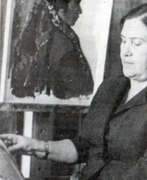

Yevgeniya Mikhailovna Adamova (Russian: Евгения Михайловна Адамова) was a Soviet artist of the second half of the twentieth century. She is known as a painter, People's Artist of the Turkmen SSR.
Yevgeniya Adamova, who moved to Turkmenistan from Ukraine in her youth, was educated at the Ashgabat Art School. During the Great Patriotic War, she creatively expressed herself as a poster artist in the TurkmenTAG agency. The artist created thematic paintings dedicated to the life of the Turkmen people and portraits. She held the post of deputy chairman of the Union of Artists of Turkmenistan.


Taisia Kirillovna Afonina (Russian: Таисия Кирилловна Афонина) was a Soviet artist of the second half of the twentieth century. She is known as a painter, graphic artist, representative of the Leningrad school.
Taisia Afonina participated in exhibitions since 1940, creating portraits, landscapes, genre compositions, still lifes and etudes. At the beginning of her career she was interested in military subjects, and then delved into the genre of portraiture and lyrical landscape. Her style is characterized by tonal painting, the rendering of light and air environments and subtle coloristic combinations. In the 1980s she preferred the watercolor technique, painting flowers such as roses, daisies and tulips. Her works are in museums and private collections in Russia and other countries.


Yuri Albert is a contemporary Russian artist, art theorist and educator; a member of the Moscow conceptualist circle. He currently lives and works in Moscow and Cologne.
Yuri Albert's works are in the collections of major Russian and international institutions.


Pyotr Filippovich Alberti (Russian: Пётр Филиппович Альберти) was a Soviet and Russian artist of the second half of the twentieth century. He is known as a painter, a representative of the Leningrad school.
Pyotr Alberti created portraits, landscapes, genre paintings. He actively exhibited since 1951 in Leningrad, demonstrating his works along with the masters of his time. The artist had a broad writing and bright coloring, expressive stroke and used various techniques. He paid special attention to the study of nature. In the late period of his career, he became fond of still life paintings with favorite motifs such as peonies and watermelons.
Alberti's works are preserved in museums and collections around the world.


Nikolai Ivanovich Andronov (Russian: Николай Иванович Андронов) was a Soviet artist of the second half of the twentieth century. He is known as a painter, muralist and teacher, considered one of the founders of the "severe style" in the art of the USSR.
Nikolai Andronov actively worked to liberalize the Soviet art scene. At the beginning of his career, he created thematic paintings, later focusing on landscapes. The artist was also involved in the decoration of buildings, including the clubhouse of the Soviet Embassy in the United States, the Paveletsky Railway Station and subway stations in Moscow. From 1992, he taught at the Surikov Moscow Art Institute and headed the composition department.


Valery Vladimirovich Androsov (Russian: Валерий Владимирович Андросов) is a Soviet and contemporary Russian artist. He is known as a sculptor, architect, designer, painter, graphic artist and teacher.
Valery Androsov creates landscapes, still lifes and portraits, as well as fantasy works. He is also known as the author of a large collection of ex-libris that accurately convey the character and interests of book owners. At different periods he served as chief artist of the Mosstroiplastmass Combine and director of the Mytishchi Picture Gallery. He also created monuments to those who died in the Great Patriotic War and to the pilots of the Mytishchi Aero Club, showing his skill in various artistic directions.


Boris Izraelievich Anisfeld (Russian: Борис Израилевич Анисфельд) was a Russian-American painter, set designer, illustrator, and educator, celebrated for his vivid use of color and imaginative scenery. Born in Bessarabia, Russian Empire, in 1878, Anisfeld's artistic journey led him from the Odessa School of Art to the Imperial Academy of Arts in Saint Petersburg, where he absorbed the influences of prominent artists like Ilya Repin and Igor Grabar. His distinct style caught the attention of Sergei Diaghilev, leading to his work with the Ballet Russe before World War I.
Anisfeld's contributions to art extend beyond his canvas, as his theater designs for Diaghilev's Ballets Russes and collaborations with notable figures like Michel Fokine and Anna Pavlova showcased his ability to blend fantasy with performance. His work with the Ballets Russes, including designing the production of "Sadko" and executing the visions of other celebrated artists for stage sets, marked a significant period in his career before he immigrated to the United States in 1917.
In America, Anisfeld continued his legacy, taking on roles such as a teacher at the Art Institute of Chicago and contributing to the cultural landscape through his stage designs and paintings. His work is recognized for its innovative approach to color and form, bridging the realms of painting and theater design to create immersive, emotionally resonant artworks. Anisfeld passed away in 1973, leaving behind a body of work that continues to inspire and captivate audiences.
For collectors and experts in art and antiques, Anisfeld's work represents a fusion of Russian and American art traditions, enriched by his imaginative approach and vibrant palette. His contributions to the development of modern art and theater design underscore the enduring relevance of his creative vision.
To stay updated on exhibitions, sales, and auctions related to Boris Israelievich Anisfeld, sign up for updates. This subscription will ensure you're informed about new opportunities to explore and acquire works by this influential artist.


Vladislav Leopoldovich Anisovich (Russian: Владислав Леопольдович Анисович) was a Soviet artist of the mid-twentieth century. He is known as a painter, graphic artist and teacher, a representative of the Leningrad school of painting.
Vladislav Anisovich participated in various exhibitions since 1935. His work included portraits, historical and genre compositions, as well as landscapes. Among the famous paintings of the artist are "The passage of K. Voroshilov's detachment from Lugansk to Tsaritsyn", "Assault on Perekop" and others. The master taught at the Leningrad Institute of Painting, Sculpture and Architecture.
His works are in various museums and private collections in many countries, including the State Russian Museum.


Evgenia Petrovna Antipova (Russian: Евгения Петровна Антипова) was a notable Russian painter, graphic artist, and art teacher. She stood out for her genre compositions, portraits, landscapes, and still lifes, primarily utilizing oils and watercolors. Evgenia Antipova's works often depicted apple orchards and Crimean landscapes, showcasing her profound connection to nature and her ability to capture its essence.
Evgenia Antipova's education at the prestigious Repin Institute of Arts shaped her artistic journey, leading to a career enriched with personal exhibitions and a significant presence in the art community. Not only did her artworks gain recognition in Russia, but they also found their way into international collections and exhibitions, notably in France, Germany, the United States, and the United Kingdom.
Throughout her career,Evgenia Antipova was an active participant in various significant exhibitions, displaying her works alongside other renowned artists. Her contributions to the art world were recognized with personal exhibitions in Saint Petersburg and inclusion in art auctions and exhibitions abroad.
Evgenia Antipova's paintings are part of prestigious collections, including the State Russian Museum, and continue to be celebrated in art museums and private collections globally. Her legacy as a prominent figure in the Leningrad School of painting endures, captivating art enthusiasts and collectors with her vivid and emotionally resonant works.
For those interested in Russian art, particularly the Leningrad School of painting, Evgenia Petrovna Antipova's oeuvre offers a rich exploration of genre compositions and landscapes, reflecting the artistic vibrancy of her era. Collectors and art experts are encouraged to delve into her works and consider signing up for updates on exhibitions and sales featuring her paintings.


Fyodor Vasilievich Antonov (Russian: Фёдор Васильевич Антонов) was a Soviet and Russian artist of the twentieth century. He is known as a painter, graphic artist, textile artist, teacher, and professor.
Fyodor Antonov created landscapes, portraits and thematic compositions. In his genre works he immortalized the life and life of Soviet youth, as well as the formation of industry in the USSR. During the Great Patriotic War, the artist created portraits of heroes, as well as posters with a simple and direct pictorial form. Antonov's works are in various museum collections, including the Tretyakov Gallery, the Russian Museum and many private collections.


Pyotr Yakovlevich Anurin (Russian: Петр Яковлевич Анурин) was a Soviet and Russian artist of the second half of the twentieth century. He is known as a painter, author of lyrical landscapes, often depicting the architecture of ancient Russian cities.
Pyotr Anurin was nicknamed "spring artist" by his contemporaries for his subject matter, style and technique of painting. Spring was a special time for the master, during this period he created many canvases, such as "Spring", "The Last Snow" and others. The main theme of his works in the last years of his life was the Central Russian landscape.
The artist's works are in various art galleries and private collections in many countries, including Russia, England, Germany, France, Israel and China.


Anatoly Afanasyevich Arapov (Russian: Анатолий Афанасьевич Арапаов) was a Russian and Soviet artist, born in St. Petersburg in 1876 and passing away in Moscow in 1949. His artistic journey began after graduating from high school in 1892, leading him to study at the Moscow Boundary Institute where he initially acquired artistic skills. Arapov's dedication to art became undeniable, prompting him to enroll in the Moscow School of Painting, Sculpture and Architecture in 1897, where he was deeply involved in applied art, book design, and theater.
Arapov's early works, particularly around 1900 and 1910, were influenced by Symbolism, but he transitioned through a phase of Constructivism in the 1920s before dedicating himself to Socialist Realism from the 1930s onward. His versatile talent spanned across painting, graphic arts, and set design, making significant contributions to theater and film. Notably, he designed plays for leading theaters across major Russian cities and worked on popular films in the 1920s and 1930s.
His oeuvre includes portraits, still lifes, and landscapes, featuring views of ancient parks and Russian architecture. Arapov's works are celebrated for their stylistic diversity, capturing the essence of Symbolism, Constructivism, and Socialist Realism. His contributions are recognized in museum collections, including the State Tretyakov Gallery and the Saratov State Art Museum named after Radishchev, among others.
For collectors and art experts, Arapov's works offer a glimpse into the evolving art styles of early to mid-20th century Russia. To stay informed on sales and auction events featuring Anatoly Afanasyevich Arapov's art, signing up for updates can provide exclusive access to new discoveries and opportunities to acquire pieces by this multifaceted artist.


Yeranui Arshakovna Aslamazyan (Russian: Ерануи Аршаковна Асламазян) was a Soviet and Russian artist of the second half of the twentieth century of Armenian origin. She is known as a painter and graphic artist.
Yeranui Aslamazyan created portraits, landscapes, still lifes and genre paintings. She also experimented with theater design, prints and ceramics. An Orientalist artist, she was part of the Soviet artistic elite in Leningrad and Moscow. With the support of the Soviet Union authorities, she traveled the world, visiting many countries. Her works are in museums in London, Sofia, Berlin, St. Petersburg, Venice, Tokyo, and Delhi.


Mariam Arshaki Aslamazyan (Russian: Мариам Аршаковна Асламазян) was a renowned Soviet-Armenian painter, often hailed as the "Armenian Frida Kahlo" due to her vibrant and expressive works that prominently featured elements of Armenian culture. Born on October 20, 1907, in Alexandropol (now Gyumri), Armenia, Aslamazyan was celebrated for her unique style which blended traditional Armenian themes with modernist influences.
Throughout her career, Aslamazyan's artwork received significant accolades, including the prestigious titles of People's Artist of the Armenian SSR in 1965 and People's Artist of the Soviet Union in 1990. Her paintings are characterized by their vivid colors and dynamic compositions, often focusing on still lives, narrative scenes, and portraits.
Aslamazyan's works are preserved and displayed in several major collections, notably at the Gallery of Mariam and Eranuhi Aslamazyan Sisters in her hometown, which showcases an extensive array of her oil paintings and ceramic works. Her artistic legacy continues to be celebrated in exhibitions and holds a significant place in Armenian cultural heritage.
For those interested in exploring more about Mariam Arshaki Aslamazyan's life and art, or in acquiring works associated with her, consider subscribing for updates on new product sales and auction events related to her work. This subscription will keep you informed about opportunities to engage with Aslamazyan's art legacy.


Robert Petrosovich Avakyan (Russian: Роберт Петросович Авакян) was a Soviet and Uzbek artist of the second half of the twentieth and early twenty-first centuries of Armenian origin. He is known as a painter, graphic artist, sculptor and teacher.
Robert Avakyan was trained in painting, but he is most famous as an author of monumental sculptures. He worked actively in Tashkent, participating in numerous exhibitions, including international sculpture competitions. The master also left his mark in such Uzbek cities as Bukhara, Nukus and Yangibazar, where he created significant monumental works.


Gennady Fyodorovich Babikov (Russian: Геннадий Фёдорович Бабиков) was a Soviet and Turkmen artist of the twentieth century. He is known as a painter, graphic artist, watercolorist, master of landscape and still life and is considered the founder of the genre of Turkmen industrial landscape, representative of the Russian academic school of painting in Central Asia.
Gennady Babikov participated in the Great Patriotic War, at the front he created more than 100 graphic portraits of fellow soldiers. The artist was famous for his linocuts, and also developed a still life style, which was called "Babikov's" in Turkmenistan.
His works are in many private collections around the world.


Stanislav Gennadievich Babikov (Russian: Станислав Геннадьевич Бабиков) was a Soviet and Turkmen artist of the mid-twentieth century. He is known as a painter, graphic artist, publicist, scenographer, as well as the son and pupil of Gennady Babikov, the founder of the Turkmen industrial landscape genre.
Stanislav Babikov is considered a continuator of the ideas of Russian Cezannism. He was a member of the informal Turkmen group "Seven", which sought to synthesize national elements and Western modernism in art. The master was also an author of articles on fine arts. His style reflects the influence of nature and climate of Turkmenistan and is characterized by bright color and expressiveness of color.


Sattar Bahlulzade (Russian: Саттар Бахлул оглы Бахлулзаде) was a 20th-century Azerbaijani Soviet landscape painter. He is known as a painter, graphic artist, landscape painter and caricaturist.
Bahlulzade created lyrical landscapes praising Azerbaijani nature, which were characterized by realism and detail. As a classical landscape painter he was especially famous for his second period of creativity (1940-1960). The artist's paintings were closely intertwined with the traditions of Azerbaijani art, and in the last years of his life the influence of Neo-Impressionism was manifested. Bahlulzade also created graphic works, including still lifes.
World museums preserve about 150 paintings and 30 graphic works by this artist.


Irina Mikhailovna Baldina (Russian: Ирина Михайловна Балдина) was a Soviet and Russian artist of the second half of the twentieth and early twenty-first centuries. She is known as a painter, a representative of the Leningrad school.
Irina Baldina participated in exhibitions in Leningrad since 1952. Her work covered a variety of genres, including portraits, landscapes, still lifes and genre compositions. From 1960 to 1980, her works were characterized by themes of modernity, nature and people of Zaonezhye. Her style was characterized by broad brushstrokes, decorative and mastery in conveying the colors of northern nature.
Her works are in museums and private collections all over the world, including Russia, France, USA, Japan and other countries.


Vladimir Davidovich Baranov-Rossine (Russian: Владимир Давидович Баранов-Россине) was a master of the Russian avant-garde, a prolific painter, sculptor, and inventor, whose work significantly contributed to the Cubo-Futurism movement. Born on January 1, 1888, in Kherson, he was originally named Shulim Wolf Leib Baranov but is best known by his pseudonym, Daniel Rossine. His early artistic education took place in Odessa and then at the St. Petersburg Academy of Arts, laying the groundwork for his future as a revolutionary artist.
In 1910, Baranov-Rossine moved to Paris, a pivotal move that introduced him to the burgeoning European avant-garde scene. It was there, alongside other notable artists such as Marc Chagall, Osip Zadkine, Alexander Archipenko, and Chaim Soutine, that he became an inhabitant of the famous Parisian house "La Ruche." His innovative work, particularly the invention of the Optophonic Piano, which projected colors in sync with music, underscored his commitment to blending art and technology, a hallmark of his career.
Tragically, Baranov-Rossine's life was cut short when he was arrested by the Gestapo in 1943 and subsequently died in Auschwitz in 1944. Despite his untimely death, his legacy lives on through his contributions to modern art and technology. His works can be found in various museums and galleries, celebrated for their vibrant expression and avant-garde techniques that continue to inspire artists and collectors alike.
For those intrigued by Vladimir Davidovich Baranov-Rossine's pioneering work and its lasting impact on the art world, signing up for updates on new product sales and auction events related to this avant-garde master is highly recommended. This ensures enthusiasts and collectors are always informed about the latest opportunities to engage with Baranov-Rossine's remarkable legacy.


Issa Abasovich Barkhanoyev (Russian: Исса Абасович Барханоев) was a Soviet and Russian Ingush artist of the last quarter of the twentieth and early twenty-first centuries. He is known as a painter, draughtsman, landscape painter, genre painter and poet, a self-taught artist.
Issa Barkhanoyev created more than 500 paintings during his career, in which, according to critics, he skillfully conveyed his deep thoughts and feelings through images and symbols, and these works of art epitomize spirituality and life philosophy. The works of the folk artist are in museums of the Republic of Ingushetia and private collections.


Pavel Ivanovich Basmanov (Russian: Павел Иванович Басманов) was a Soviet and Russian artist of the twentieth century. He is known as a painter, book graphic artist and illustrator.
Pavel Basmanov devoted his entire career, beginning in 1929, to book graphics, and was a member of the bureau of the graphic section of the Union of Artists. He is also known for his series of watercolor works, including "Old Siberia" and "Walking". His art was characterized by a unique approach based on religious motifs.
The master's works are in the collections of the State Russian Museum, the Tsarskoye Selo State Collection and private collections.


Elena Mikhailovna Bebutova (Russian: Елена Михайловна Бебутова) was a Russian and Soviet artist of the mid-twentieth century of Georgian-Armenian origin. She is known as a painter, graphic artist and scenographer.
Elena Bebutova evolved from a fascination with cubism and futurism in her early work to a more decorative and realistic style. In 1917, she began working on the decoration of performances in various theaters in Russia, and held a personal exhibition in Moscow in 1923. Returning to the USSR after business trips to Berlin and Paris, she became one of the founding members of the society "Four Arts". Her work in the theater was closely linked to the directing activities of her brother Valery Bebutova; their last collaboration was a production of Hamlet at the Vitebsk Belorussian Theater in 1946 and 1955.
Bebutova is also known as a model for portraits created by her husband Pavel Kuznetsov.


Victoria Markovna Belakovskaya (Russian: Виктория Марковна Белаковская) was a Russian Soviet artist of the mid-twentieth century. She is known as a painter, graphic artist and representative of the Leningrad school of painting.
Victoria Belakovskaya participated in exhibitions of Leningrad artists since the early 1930s. Her work covers various genres, including portraits, genre compositions, still lifes and landscapes. Her famous works include "Pioneer Girl" (1931), "Self-Portrait with a Cigarette" (1936), "Leningrad Landscape" (1953), "Spring Flowers. Still Life" (1961), a series of landscapes of Altai, Crimea, Kiev and others.
Works by the artist are in the collections of museums in Russia, Great Britain, USA, France and other countries.
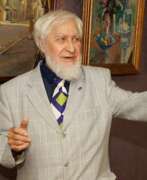

Yuri Vladimirovich Belov (Russian: Юрий Владимирович Белов) was a Soviet and Russian artist of the second half of the twentieth and early twenty-first centuries. He is known as a painter, a representative of the Leningrad school, who worked in the genres of portrait, landscape, still life and historical painting.
Yuri Belov actively participated in exhibitions since 1954. In 1960-1980 the main theme of his work was the images of Lenin and the history of the revolutionary movement. The artist's manner evolved from strict objectivism to a more decorative and impressionistic style.
The master's works are in museums in Russia, France, the USA, Germany and other countries, as well as in private collections.


Igor Borisovich Berezovsky was a Soviet and Russian artist, graphic artist and designer.
Igor Berezovsky was interested in the texture of television images; he reproduced magazine photographs and brought them to the brink of extinction with the help of large screen prints; he introduced unexpected textures into images using all kinds of "rubbish"; he paraphrased Folon and Dibbets, Warhol and Dürer.
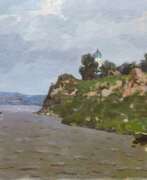

Yakov Tarasovich Besperstov (Russian: Яков Тарасович Бесперстов) was a Russian Soviet artist of the second half of the twentieth century. He is known as a painter, muralist, representative of the Leningrad school of painting.
At the initial stage of his career, Yakov Besperstov worked in the field of monumental and decorative painting, participating in the painting of various buildings. Later he moved to easel painting, creating portraits, genre paintings, as well as urban landscapes. His works were exhibited at exhibitions from the late 1950s and were appreciated by leading artists of Leningrad. The master traveled extensively throughout various regions of Russia and other countries, including France.
His works are in museums and private collections in various countries, including Russia, France, Belgium, Germany, Spain and Italy.


Georgy Nikolaevich Bibikov (Russian: Георгий Николаевич Бибиков) was a Russian and Soviet artist of the mid-20th century. He is known as a painter, graphic artist, illustrator, muralist and theater artist of the Leningrad school, working in the genres of landscape, portrait, still life and thematic painting.
Georgy Bibikov began participating in art exhibitions in 1920. Among his famous works are "Loaders", "Young Red Fleets Receive Uniforms", "Greetings to the Winners", "Trench Truth" and others. His works are in the State Russian Museum and in museums and private collections in Russia, Ukraine, Germany and France.
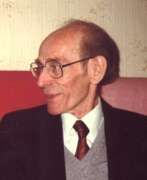

Boris Georgievich Birger (Russian: Борис Георгиевич Биргер) was a Soviet artist of the second half of the twentieth century of Jewish origin. He is known as a portrait painter, a representative of "unofficial art", a follower of symbolism.
Boris Birger developed his individual style of portrait painting, recognizable by his colorism. He often portrayed representatives of the liberal creative intelligentsia and was twice expelled from the Union of Artists of the USSR because of his criticism of official cultural policy.
In the 1970s his work was recognized abroad, especially in Germany, and from 1990 he lived in that country.
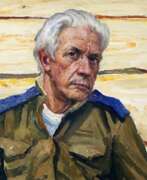

Mikhail Grigorievich Bogatyryov (Russian: Михаил Григорьевич Богатырёв) was a Soviet and Russian artist of the second half of the twentieth century. He is known as a painter.
Mikhail Bogatyryov participated in the Great Patriotic War, was wounded and became disabled. His work focused on the theme of war and the life of rural toilers. He also created works in the genres of still life and landscape. His paintings are in museum collections, including Russian regional art galleries, as well as private collections in Russia and abroad, including countries such as France, Japan, Germany and Italy.


Olga Borisovna Bogayevskaya (Russian: Ольга Борисовна Богаевская) was a Soviet and Russian artist of the second half of the twentieth century. She is known as a painter, graphic artist, teacher, and representative of the Leningrad school.
At the beginning of her career, Olga Bogayevskaya taught painting at the Secondary Art School of the Leningrad Institute of Painting, Sculpture and Architecture and participated in exhibitions. Her works, notable for their uncommon colorism, included children's portraits, interior and exterior still lifes. In 1950-1960 she was already considered one of the leading artists of Leningrad.
Her works are in many museums and private collections around the world, including the State Russian Museum and the State Tretyakov Gallery. Bogayevskaya also exhibited successfully abroad, including France.


Ilia Bolotovskii (russian: Илья Юльевич Болотовский) was a Russian-born American abstractionist painter.
After spending his youth in Baku, he moved to the United States in 1923, later becoming an American citizen. Bolotovskii received his artistic education at the National Academy of Drawing in New York and while traveling in Europe. Influenced by the work of P. Mondrian began to create objectless paintings and later remained an adherent of abstractionism, was a member of the abstract-expressionist group "Ten".
In 1936 Bolotovskii created one of the first abstract monumental murals in the United States in the Williamsburg housing project in New York. That same year he co-founded the American Abstract Artists organization. In the 1960s, Bolotovskii worked in the spirit of geometric abstractionism and neo-plasticism and created canvases with images in three dimensions.
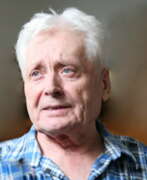

Vasily Pavlovich Borisenkov (Russian: Василий Павлович Борисенков) was a Soviet and Russian artist of the second half of the twentieth and early twenty-first centuries. He is known as a painter and teacher, a representative of the Leningrad school of painting.
Vasily Borisenkov actively participated in Leningrad art exhibitions since 1954, was the author of genre and battle paintings, landscapes and portraits. Among his famous works are the paintings "Difficult Conversation", "Spring", "Strelna. The Beginning of Summer" and many others. The master's works are in museums and private collections both in Russia and abroad.
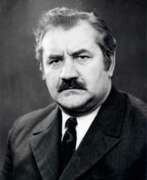

Nikolai Yakovlevich Bout (Russian: Николай Яковлевич Бут) was a Soviet artist of the second half of the twentieth century. He is known as a painter and graphic artist, a master of the battle genre.
Nikolai Bout began painting from his teenage years and immediately showed an interest in depicting historical battles. Throughout his career as a professional artist, he lived in Moscow, and spent the summer months in Kerch, where the subjects of many of his paintings originated. He painted portraits, battle and genre paintings, and landscapes. His works include the cycle "Adzhimushkay. 1942", series of paintings "Slovak National Uprising", "Heroic Marines" and other works.
Bout was an artist of the M. B. Grekov Studio of Military Artists since 1958.


Eduard Georgievich Bragovsky (Russian: Эдуард Георгиевич Браговский) was a Soviet and Russian artist of the second half of the twentieth and early twenty-first centuries. He is known as a painter who specialized in the genres of landscape, portrait and still life.
Eduard Bragovsky closely connected his creative destiny with the Russian town of Tarusa, where he lived for several years. He painted many paintings, creating a "portrait" of the town. The artist actively traveled around the country, creating works from nature. His works were exhibited in various museums in Russia, the CIS and other countries, as well as at personal exhibitions in different parts of the world.
He actively participated in the work of the Moscow Union of Artists, was a member of the Board, headed the painting section.


Piotr Dmitrievich Buchkin (Russian: Пётр Дмитриевич Бучкин) was a multifaceted Soviet and Russian artist known for his contributions to painting, graphic arts, and teaching. Educated at the Higher Art School at the Imperial Academy of Fine Arts under Vasiliy Mate and Vasily Savinsky, Piotr Buchkin graduated in 1912, embarking on a journey that included travels across Europe to refine his artistry. His works span a variety of genres, including portraits, genre paintings, landscapes, and illustrations, showcasing his versatility across different mediums such as watercolor, pencil, pastels, etchings, oil, and tempera paintings.
Piotr Buchkin's engagement with the art world was profound; he was a founding member of the Leningrad Union of Artists and contributed significantly to the Leningrad School of Painting. Throughout his career, Buchkin participated in numerous exhibitions and was recognized for his talent as a graphic artist and portraitist, adept in various painting techniques. His memoirs, "About that in memory: Notes of an Artist," provide insights into his artistic journey and experiences.
Piotr Dmitrievich Buchkin's works are held in prestigious collections, including the State Russian Museum and the State Tretyakov Gallery, reflecting his esteemed position in the art community. His legacy continues to inspire, as his works are found not only in Russia but also in private collections and museums worldwide.
For collectors and experts in art and antiques, Piotr Buchkin's oeuvre offers a deep dive into the richness of Soviet and Russian art, particularly the Leningrad School. To stay updated on exhibitions, sales, or auctions featuring Buchkin's works, consider subscribing to relevant updates.
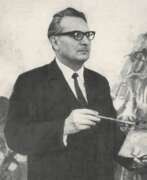

Alexander Gavrilovich Budnikov (Russian: Александр Гаврилович Будников) was a Soviet Ukrainian artist of the twentieth century. He is known as a battle painter.
During the Great Patriotic War Alexander Budnikov worked for a frontline newspaper, created posters and sketches from the battlefields. After the war he studied at the Kiev Art Institute, later became a teacher and professor at this institution. The artist worked in the genre of battle painting, and was also the author of a series of landscapes from different countries. His works are kept in museums in Ukraine, Russia and in private collections in Europe, the USA and Canada.
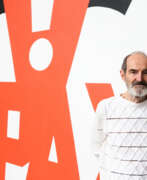

Erik Vladimirovich Bulatov (Russian: Эрик Владимирович Булатов) is a Soviet and Russian avant-garde artist of the XX-XXI centuries. His paintings are an experimental confrontation of modernist style and traditional painting. The main principle of Bulatov's paintings is the confrontation of the real space and the pictorial plane.
Since 1989, Bulatov lived in New York, and in 1992, he moved to the capital of France, where he lives and works to this day, sometimes visiting Russia.
Bulatov's works are in constant demand at auctions of contemporary art, he is considered one of the most expensive contemporary Russian artists. For example, his work "Soviet Cosmos" was sold for about $1.6 million at the Phillips auction.


Zlata Nikolaevna Byzova (Russian: Злата Николаевна Бызова) was a Soviet and Russian artist of the second half of the twentieth and early twenty-first centuries. She is known as a painter, a representative of the Leningrad school, famous for her genre compositions, portraits, landscapes and studies from life.
Zlata Byzova achieved particular success in provincial portrait-types and Old Ladoga sketches of the 1960s-1970s. Her works were successfully presented at exhibitions and auctions of Russian painting in France in 1989-1992.
The artist's works are in museums and private collections in Russia, Finland, Germany, France and other countries.


Ivan Ivanovich Chorny (Russian: Иван Иванович Чёрный) was a Soviet, Ukrainian and Russian artist of the second half of the twentieth and early twenty-first centuries. He was known for his monumental and decorative works in the style of socialist realism.
Ivan Chorny reoriented his style in the late 1990s, inventing a new technique and moving away from figurativeness in favor of abstract painting. His enigmatic compositions became an expressive expression of inner feelings enriched with colors and lines.




